
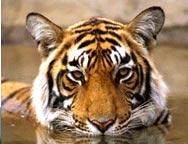
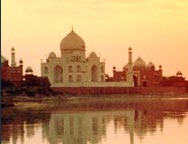
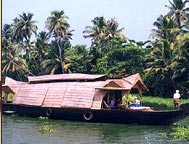
    |
| YEAR | INDIA | EUROP |
| 3000 B.C. |
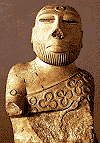 Indus-Culture Indus-Culture
(3000-1500 B.C.)
|
Minoic Culture |
| 1000 B.C. |
Vedic Period (1500-500 B.C) |
Greek Period |
| 0 Chr. |
 Shakyamuni
Buddha Shakyamuni
BuddhaPre Buddhistic Period (250 B.C - 50 A.D.) |
Roman Period |
| 100 A.D. |
Kushana Period (50-300 A.D.) |
|
| 500 A.D. |
Gupta Period (300-600 A.D.) |
Byzantine Empire |
| 900 A.D. |
Pre Mediavel Period (600-900 A.D.) |
Roman |
| 1200 A.D. |
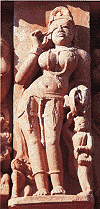 Late
Mediavel Art Late
Mediavel Art(900-1300 A.D.) |
|
| 1300 A.D. | Islamic Invasion and the decline of Hindu Art in the North | Gothic, Lategotic |
| 1400 A.D. | Late Hindu-Art of Southern India | Pre Renaissance |
| 1500 n.Chr. | Jain-Miniatures | Pre Renaissance Renaissance and Manierism |
| 1500 A.D. |
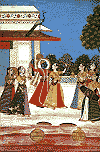 Rajput
Paintings (1600-1800 A.D.) Rajput
Paintings (1600-1800 A.D.) |
Barock und Rokoko |
| 1800 A.D. | Kangra Paintings (1700-1850 A.D.) |
Klazissismus, Romantic, Realism |
| 1900 A.D. | Modern Art | Modern Art |
Museums & Art Galleries During the last few years, the
contemporary art scene in the country has blossomed into a high profile
attention getter, auctioned at never before prices by international
auctioneers. The works of all India’s best artists are pre sold almost
always, but can sometimes be seen at art galleries in New Delhi, Bombay,
Madras, Calcutta, Vadodara and Trivandrum. Art exhibitions are held in these
cities from time to time, and feature solo and group shows. Museums all over
the country exhibit objects that range from finds at archaeological sites,
miniature paintings, royal memorabilia to India’s finest traditional crafts.
Of course, this varies from one museum to another. New
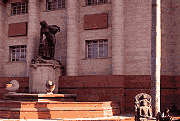 Delhi’s
National Museum exhibits a range from terra-cotta figures of the 5th and
6th centuries BC to exquisitely damascened swords of the Mughal period. Also
in New Delhi, the Crafts Museum displays the folk art of India.
Periodical exhibitions include textiles, wooden sculptures of coastal India
and other thematic subjects. Jaipur’s City Palace, itself an object of
wonder, houses a collection of royal i2 memorabilia, as do the museums in
other parts of Rajasthan: Bikaner, Jodhpur, Jaisalmer, Alwar and Bundi. Each
of these were princely states whose rulers were great patrons of art, and
miniature paintings in the distinctive style of each state forms the nucleus
of many a museum’s treasures. In Gujarat, the city of Ahmedabad has a
sprinkling of museums, all the private collections of an individual or a
family. The Shereyas Museum of Folk Art, the Calico Museum of
Textiles, the Kite Museum and the Utensils Museum, each
display another facet of the rich heritage of craft traditions of Gujarat.
Vadodara’s museum is housed in an old palace building and includes extremely
rare bronze figurines. In the north, Jammu’s two museums display a valuable
collection of miniature paintings collectively known as ’Pahari’ or hill
schools. Srinagar’s SPS Museum is the only place in India where one
can see stone sculptures of deities executed in the distinctive style that
was a hallmark of Kashmir in the 7th to 11th centuries. Bhopal’s museum
revolves around the considerable tribal skill of Madhya Pradesh, the focus
of which is dhokra figures, made in the lost wax technique out of bell
metal. Pune’s Dinkar Kelkar Museum is the lifelong collection of one
man whose theme was the celebration of everyday life in art. Ink pots,
cooking vessels and betel nut crackers, all display the wealth of everyday
art. Hyderabad’s most famous museum is the Salar Jung Museum, again a
personal collection which features priceless treasures and whimsical objects
side by side. Trivandrum has a museum whose building is probably the most
photographed edifice in the city. Objects displayed inside are exquisitely
carved bronze temple figures. Cochin has a number of museums housed in
buildings that were built by the Dutch as palaces, and by local rulers. A
small museum on the outskirts of the city is the Museum of Natural
History, the vision of its founder. Sound and light shows bring to life
all the figures exhibited that range from classical dancers to Portuguese
traders. Calcutta too has a museum that was the personal collection of one
family, at Mallick’s Palace. It is impossible to give a brief account
of a subject that requires a full volume to itself. Every city or town in
the country will have a museum featuring classical, tribal or folk art.
Information regarding timings and special exhibitions will be available at
the hotel counter.
Delhi’s
National Museum exhibits a range from terra-cotta figures of the 5th and
6th centuries BC to exquisitely damascened swords of the Mughal period. Also
in New Delhi, the Crafts Museum displays the folk art of India.
Periodical exhibitions include textiles, wooden sculptures of coastal India
and other thematic subjects. Jaipur’s City Palace, itself an object of
wonder, houses a collection of royal i2 memorabilia, as do the museums in
other parts of Rajasthan: Bikaner, Jodhpur, Jaisalmer, Alwar and Bundi. Each
of these were princely states whose rulers were great patrons of art, and
miniature paintings in the distinctive style of each state forms the nucleus
of many a museum’s treasures. In Gujarat, the city of Ahmedabad has a
sprinkling of museums, all the private collections of an individual or a
family. The Shereyas Museum of Folk Art, the Calico Museum of
Textiles, the Kite Museum and the Utensils Museum, each
display another facet of the rich heritage of craft traditions of Gujarat.
Vadodara’s museum is housed in an old palace building and includes extremely
rare bronze figurines. In the north, Jammu’s two museums display a valuable
collection of miniature paintings collectively known as ’Pahari’ or hill
schools. Srinagar’s SPS Museum is the only place in India where one
can see stone sculptures of deities executed in the distinctive style that
was a hallmark of Kashmir in the 7th to 11th centuries. Bhopal’s museum
revolves around the considerable tribal skill of Madhya Pradesh, the focus
of which is dhokra figures, made in the lost wax technique out of bell
metal. Pune’s Dinkar Kelkar Museum is the lifelong collection of one
man whose theme was the celebration of everyday life in art. Ink pots,
cooking vessels and betel nut crackers, all display the wealth of everyday
art. Hyderabad’s most famous museum is the Salar Jung Museum, again a
personal collection which features priceless treasures and whimsical objects
side by side. Trivandrum has a museum whose building is probably the most
photographed edifice in the city. Objects displayed inside are exquisitely
carved bronze temple figures. Cochin has a number of museums housed in
buildings that were built by the Dutch as palaces, and by local rulers. A
small museum on the outskirts of the city is the Museum of Natural
History, the vision of its founder. Sound and light shows bring to life
all the figures exhibited that range from classical dancers to Portuguese
traders. Calcutta too has a museum that was the personal collection of one
family, at Mallick’s Palace. It is impossible to give a brief account
of a subject that requires a full volume to itself. Every city or town in
the country will have a museum featuring classical, tribal or folk art.
Information regarding timings and special exhibitions will be available at
the hotel counter.
The Orissa State Museum A visit to the museum provides an instant overview of Orissa as it was and still is. It has a rich collection of sculptures, coins, copper plates, stone inscriptions, lithic and bronze age tools, rare manuscripts written on palm leaves, traditional and folk musical instruments.
The Handicrafts Museum (Secretariat Road) This museum has a splendid collection of stone sculptures, patta paintings, brass castings, horn toys and Orissa’s famous silver filigree work. Tribal Museum This museum provides an insight into the tribal culture of Orissa. Addresses of Museums & Art Galleries
![]()
A Look Aroud the Temples In Bhubaneshwar the orientalist is in for a delightful break . The temples of Laxmaneswar, Satrughaneshwar and Bharateswara built in the 6th Century AD are relics of early religious shrines in Orissa.
Parasurameswara Temple built in 650 AD is one of the few earliest temples of Bhubaneshwar. This temple built in the Kalinga style of temple architecture was dedicated to Lord Siva but there are images of Lord Vishnu, Yama, Surya and seven Mother Godesses. In typical fashion, it is liberally sculpted with amourous couples, animals and floral motifs.
Just south of Parasurameswara temple is the Swaranajaleswara temple. Built in a similar style, the motifs on the walls however differ, depicting scenes from the Ramayana.
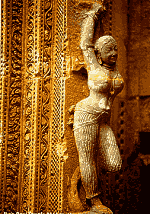 Rajarani
Temple (C 1100 AD) The Rajarani temple, is an essay in grace and poise
and is particularly interesting in that it has no presiding deity. The name
of this temple is supposed to be derived from the red- gold sand stone used
- Rajarani being the local name for the stone. The Deul is intricately
carved with figurines in various stages of daily chores. The lower portion
of the Deul has the ’Guardians of the eight directions’ guarding the eight
cardinal points of the temple.
Rajarani
Temple (C 1100 AD) The Rajarani temple, is an essay in grace and poise
and is particularly interesting in that it has no presiding deity. The name
of this temple is supposed to be derived from the red- gold sand stone used
- Rajarani being the local name for the stone. The Deul is intricately
carved with figurines in various stages of daily chores. The lower portion
of the Deul has the ’Guardians of the eight directions’ guarding the eight
cardinal points of the temple.
Vaital Deul ( C 800 AD) Vaital Deul is the Shrine of Chamunda (a tantric form of the Goddess Kali) or Shakti. Seated on a corpse in a dark inner sanctum is the Goddess Chamunda, garland of skulls round her neck and flanked by a jackal and an owl. The niches on the inner wall depict equally startling images along with scenes of tantric rituals. It is the first of the temples to depict erotic scultpures, it is also unique in that the outer surface of the vault is plain while profusely embellished on the inside.
Mukteswara (C 950 AD) Often referred to as the "Gem of Orissan Architecture" this temple has been built on the lines of the Kalinga School of temple architecture. This temple too is a deviation in that the architects have blended old and new techniques of planning and execution, Many new innovations in later temples are from here. A ’Torana’, an arched gateway is a unique feature of this temple. The temple dedicated Lord Shiva - Mukteswara, is carved with figures of ascetics in various poses of meditation and scenes from the store house of Indian fables, the ’Panchatantra’. A dip in a sacred well to the east of the temple is supposedly a cure for infertility .
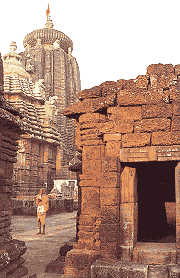 Brahmeswara
Temple (C 1050 AD) Brahmeswara temple depicts the mature Orissan style
of temple architecture. The Deul and the Jagmohana are both intricately
carved and for the first time in temple architectural history musicians and
dancers appear on the outer walls and iron beams find their first use. In
the western section Chamunda, Siva and other deities are depicted.
Brahmeswara
Temple (C 1050 AD) Brahmeswara temple depicts the mature Orissan style
of temple architecture. The Deul and the Jagmohana are both intricately
carved and for the first time in temple architectural history musicians and
dancers appear on the outer walls and iron beams find their first use. In
the western section Chamunda, Siva and other deities are depicted.
Lingaraja (11th Century AD) The Lingaraja temple dominates the skyline of Bhubaneswar from as far away as 15 kms and exhibits the skill of the Orissan temple architects at its completely mature and developed stage. This temple was constructed in the 11th AD at the site of an old seventh century shrine. Along with the Deul and the Jagmohana the Lingaraja temple has two new structures, the nata mandira (Dance Hall) and the Bhoga mandapa (offering Hall). Dedicated to Lord Siva the Lingam here is unique in that it is a hari hara lingam -half Siva and half Vishnu. Ther are around 150 subsidiary shrines within this giant temple.
| Rajasthan || Kerala || Goa || Taj Mahal || Wildlife || India Hotels || India Travel Guide || Beaches || Honeymoon |
| HOME | ABOUT US | CONTACT US | RESERVATION | EMAIL |
| Copyright © All Right Reserved MIDTOWN TRAVELS PVT. LTD. |